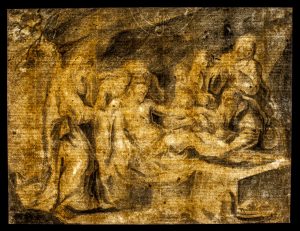Watermarks are designs embedded in paper. Used at least since the medieval period, they are created during the papermaking process by forming wires into a unique decorative pattern in the sieve-like mold that holds the pulp from which paper is made. Possibly used by papermakers as an early branding device, they only become visible in transmitted light. Modern-day versions of watermarks are still used in some paper objects, such as official government documents, and can serve to authenticate them. It remains unclear what the exact purpose of these intricate marks was initially, however, they are now widely used by scholars to provide estimated dates for works on paper and even clues about their regions of origin. While watermarks prove to be helpful in assessing when and where a certain artwork was created, their evidential value remains limited. The fact that paper was often stored and transported means that the same watermark can be found in artworks with divergent dates and places of origin.
Here you can see two watermarks discovered in drawings from the Picker Art Gallery’s collection. The first is a well-known one: the foolscap with five-pointed collar. This watermark has been documented in collections around the world. Through comparison with other examples, a two similar watermarks were identified in sheets of paper dated to ca. 1648–1651 that were in the collection of the Papermakers’ Association of Great Britain in London when published in Edward Heawood’s Watermarks. Mainly of the 17th and 18th centuries (1950, nos. 1921-1922). This allows us to establish a rough date for the Picker’s work on paper.
The second drawing contains only a partial watermark which has proved much more difficult to identify. The process of sifting through documented watermarks in databases and literature in the hopes of finding a match is still ongoing.
Research into the watermarks found in works on paper from the Picker Art Gallery’s collection was carried out by curatorial intern, Laura Macias ’21.
Watermarks are designs embedded in paper. Used at least since the medieval period, they are created during the papermaking process by forming wires into a unique decorative pattern in the sieve-like mold that holds the pulp from which paper is made. Possibly used by papermakers as an early branding device, they only become visible in transmitted light. Modern-day versions of watermarks are still used in some paper objects, such as official government documents, and can serve to authenticate them. It remains unclear what the exact purpose of these intricate marks was initially, however, they are now widely used by scholars to provide estimated dates for works on paper and even clues about their regions of origin. While watermarks prove to be helpful in assessing when and where a certain artwork was created, their evidential value remains limited. The fact that paper was often stored and transported means that the same watermark can be found in artworks with divergent dates and places of origin.
Here we will discuss two watermarks discovered in drawings from the Picker Art Gallery’s collection. The first is a well-known one: the foolscap with five-pointed collar.


This watermark has been documented in collections around the world. Through comparison with other examples, a two similar watermarks were identified in sheets of paper dated to ca. 1648–1651 that were in the collection of the Papermakers’ Association of Great Britain in London when published in Edward Heawood’s Watermarks. Mainly of the 17th and 18th centuries (1950, nos. 1921-1922).
The second drawing contains only a partial watermark which has proved much more difficult to identify. The process of sifting through documented watermarks in databases and literature in the hopes of finding a match is still ongoing.

